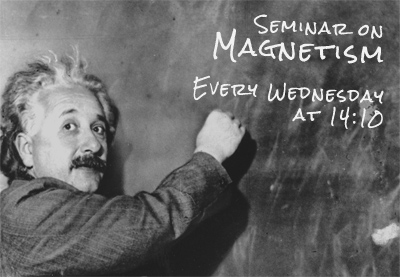Seminar on Magnetism
Group of Magnetism at the Department of Condensed Matter Physics
of Charles University and MGML has a pleasure to invite you to attend the joint seminar
on 29th May 2024 at 14:10
at Faculty of Mathematics and Physics of Charles University, Ke Karlovu 5, 121 16 Praha 2
Lecture room F2
Louis Taillefer
Institut quantique, Université de Sherbrooke, Sherbrooke, Canada International Research Lab, Quantum Frontiers, CNRS Quantum Materials Program, CIFAR
The dark phase of quantum matter
Louis Taillefer » The dark phase of quantum matter
Institut quantique, Université de Sherbrooke, Sherbrooke, Canada International Research Lab, Quantum Frontiers, CNRS Quantum Materials Program, CIFAR
Online link: cesnet.zoom.us Ask R. Colman for password.
Location: Lecture room F2, Ke Karlovu 5
In this talk, I will discuss the most mysterious of electronic phases. It could be called the dark phase of quantum matter. It exists in copper oxide materials known as cuprates.
In the copper-oxygen planes of these materials, the concentration of mobile electrons can be varied by chemical doping. At high concentration, or hole doping p, the material is a fairly conventional metal. At one hole per copper, it is a Mott insulator, where strong inter-particle repulsion localizest he electrons on their copper site. In between, at intermediate doping, cuprates exhibit the strongest ambient-pressure superconductivity we know, which persists halfway to room temperature.
My focus will be on a fourth phase, the so-called pseudogap phase, whose nature remains a mystery more than two decades after its identification. I will describe our experimental attempts at shedding light on its ground state at low temperature in the absence of superconductivity, removed by the
application of large magnetic fields [1].
Crossing below the critical doping of the pseudogap phase, p*, we observed a sharp drop in carrier density [2] and a transformation of the Fermi surface [3], akin to what antiferromagnetic order would do in a metal by breaking translational symmetry. But the pseudogap phase does not break translational symmetry.
At p*, the specific heat displays the classic thermodynamic signatures of a quantum critical point [4]. But there is no obvious long-range order ending at p*.
Upon entering the pseudogap phase, a new thermal Hall effect appears, revealing that the motion of phonons – neutral particles – is deflected by a magnetic field [5,6]. What makes phonons become chiral is a new puzzle.
Just above p*, the strong electron interactions conspire to produce an intriguing phenomenon now known as Planckian dissipation, whereby the electron scattering time is set by Planck’s constant [7,8]. The fundamental mechanism at play is currently the subject of a hot debate.
The sum of these experimental signatures, plus many more, is the increasingly enigmatic state of quantum matter many of us are trying to elucidate. Any help from the audience will be most welcome!
References
[1] Proust & Taillefer, Annual Review of Condensed Matter Physics 10, 409 (2019)
[2] Badoux et al., Nature 531, 210 (2016)
[3] Fang et al., Nature Physics 18, 558 (2022)
[4] Michon et al., Nature 567, 218 (2019)
[5] Grissonnanche et al., Nature 571, 376 (2019)
[6] Grissonnanche et al., Nature Physics 16, 1108 (2020)
[7] Legros et al., Nature Physics 15, 142 (2019)
[8] Grissonnanche et al., Nature 595, 667 (2021)


